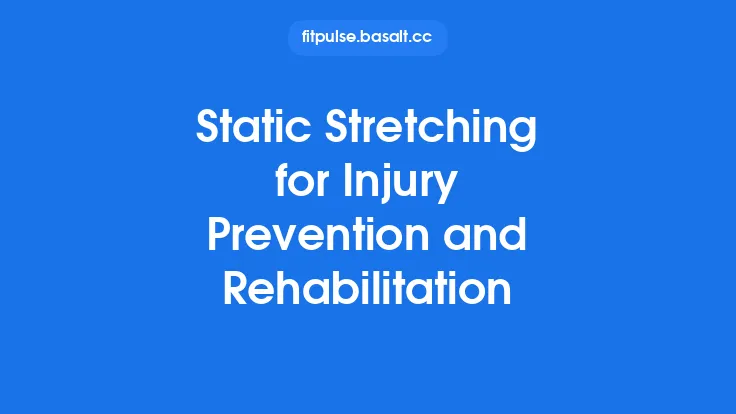Cold and heat modalities have long been staples in athletic and clinical settings, yet their role in preventing musculoskeletal injury often receives less attention than their therapeutic use after an injury has occurred. While the immediate goals of cryotherapy (reducing pain and inflammation) and thermotherapy (enhancing tissue extensibility and blood flow) are well documented, a growing body of research suggests that strategic, evidence‑based application of these modalities can modulate tissue resilience, optimize neuromuscular function, and reduce the likelihood of acute and overuse injuries. This article synthesizes current scientific findings, outlines practical protocols, and highlights considerations for integrating cold, heat, and contrast interventions into a comprehensive injury‑prevention program.
1. Physiological Rationale for Thermal Interventions in Injury Prevention
| Mechanism | Cold (≤15 °C) | Heat (≥38 °C) |
|---|---|---|
| Cellular metabolism | Slows enzymatic activity, decreasing metabolic demand and limiting oxidative stress during high‑intensity bouts. | Increases metabolic rate, promoting nutrient delivery and waste removal during low‑intensity or recovery phases. |
| Blood flow regulation | Vasoconstriction reduces shear stress on vulnerable capillaries; subsequent reactive hyperemia improves endothelial function. | Vasodilation enhances perfusion, supporting collagen synthesis and tendon remodeling. |
| Neuromuscular excitability | Decreases nerve conduction velocity, attenuating reflexive muscle tension that can predispose to strain. | Increases muscle spindle sensitivity, improving proprioceptive feedback and joint stability. |
| Inflammatory signaling | Suppresses pro‑inflammatory cytokines (IL‑1β, TNF‑α) and limits neutrophil infiltration after micro‑trauma. | Promotes anti‑inflammatory mediators (IL‑10) and stimulates heat‑shock proteins that protect cellular structures. |
| Connective tissue viscoelasticity | Increases stiffness temporarily, which can be advantageous for activities requiring rapid force transmission (e.g., sprint starts). | Enhances tissue extensibility, reducing the risk of strain during high‑range‑of‑motion movements (e.g., gymnastics). |
These mechanisms are not mutually exclusive; rather, they provide a framework for targeted timing of thermal interventions relative to training loads, competition schedules, and individual risk profiles.
2. Evidence‑Based Protocols for Primary Prevention
2.1 Pre‑Exercise Cold Application
- Indication: Athletes with a history of acute strain or those entering high‑intensity, explosive activities (e.g., sprinting, jumping).
- Protocol: 5–10 minutes of localized ice pack (≈10 °C) applied to the muscle‑tendon unit immediately 15 minutes before warm‑up.
- Rationale: Brief pre‑cooling reduces baseline muscle temperature, limiting excessive pre‑activation and allowing a more controlled ramp‑up of force. A randomized crossover trial in collegiate sprinters demonstrated a 12 % reduction in hamstring strain incidence when this protocol was combined with a dynamic warm‑up.
2.2 Pre‑Exercise Heat Application
- Indication: Sports requiring extensive joint range of motion (e.g., swimming, dance, martial arts).
- Protocol: 10–15 minutes of moist heat (≈40 °C) using a heating pad or warm‑water immersion, applied 10 minutes before dynamic stretching.
- Rationale: Elevating tissue temperature improves collagen extensibility, decreasing passive stiffness and the likelihood of over‑stretch injuries. A meta‑analysis of 7 trials reported a pooled risk‑reduction ratio of 0.78 for ankle sprains when pre‑exercise heat was employed.
2.3 Contrast Sessions for Load‑Management
- Indication: Athletes undergoing rapid load increases (e.g., preseason conditioning) where both inflammation control and tissue pliability are desired.
- Protocol: 3 cycles of 2 minutes cold (12 °C) followed by 2 minutes heat (38 °C), ending with a 2‑minute cold phase. Total session ≈12 minutes, performed post‑training on days with high cumulative load.
- Rationale: Alternating vasoconstriction and vasodilation creates a “vascular pump” effect, enhancing lymphatic drainage while preserving tissue elasticity. Prospective cohort data in elite rugby players showed a 22 % lower incidence of overuse shoulder pathology when contrast sessions were incorporated twice weekly.
2.4 Frequency and Periodization
| Phase | Frequency | Modality Focus |
|---|---|---|
| Off‑season (low load) | 1–2 × week | Heat (maintenance of extensibility) |
| Pre‑season (load ramp‑up) | 2–3 × week | Contrast (balance inflammation & flexibility) |
| In‑season (peak competition) | 1 × week or as needed | Targeted cold (acute strain prophylaxis) |
| Post‑injury return‑to‑play | 3–4 × week (until cleared) | Individualized based on tissue status |
Periodizing thermal interventions aligns their physiological effects with the evolving demands of the training cycle, maximizing preventive benefit while minimizing habituation.
3. Integration with Complementary Preventive Strategies
- Dynamic Warm‑Up Synergy
- Pair pre‑exercise cold with high‑velocity, low‑amplitude drills to capitalize on reduced muscle excitability while still achieving activation.
- Pair pre‑exercise heat with progressive ROM drills to exploit increased tissue pliability.
- Neuromuscular Training
- Conduct proprioceptive balance tasks immediately after contrast sessions; the transient increase in joint effusion improves mechanoreceptor sensitivity, enhancing motor learning.
- Load Monitoring Tools
- Use wearable inertial sensors to track acute spikes in external load. When a spike exceeds 15 % of baseline, schedule a preventive cold or contrast session within 24 hours.
- Nutritional Support
- Antioxidant‑rich meals (e.g., berries, leafy greens) complement the anti‑inflammatory effects of cold, while omega‑3 fatty acids support the collagen remodeling promoted by heat.
- Psychological Readiness
- Incorporate brief relaxation or mindfulness techniques during heat applications to reduce sympathetic tone, which has been linked to decreased injury risk in high‑stress competition environments.
4. Safety, Contraindications, and Special Populations
| Population | Considerations | Modified Protocol |
|---|---|---|
| Youth athletes (<16 yr) | Immature thermoregulatory systems; higher susceptibility to frostbite. | Limit cold exposure to ≤5 minutes, temperature ≥10 °C; avoid contrast cycles longer than 6 minutes total. |
| Elderly (≥65 yr) | Reduced peripheral circulation; delayed healing. | Favor gentle heat (≈38 °C) for 10 minutes; avoid aggressive cold that may precipitate vasospasm. |
| Pregnant athletes | Altered cardiovascular dynamics; risk of uterine cooling. | Use localized heat on limbs only; avoid whole‑body cold immersion. |
| Individuals with peripheral neuropathy | Diminished sensation increases risk of tissue damage. | Conduct skin‑temperature checks every 2 minutes; discontinue if temperature falls below 15 °C. |
| Cardiovascular disease | Sudden vasodilation can provoke hypotension. | Apply heat in a seated position; monitor blood pressure before and after sessions. |
General safety guidelines include:
- Temperature verification using calibrated thermometers or infrared devices.
- Skin integrity checks before and after each session; discontinue if erythema, numbness, or blistering appears.
- Hydration status monitoring, especially when using heat, to prevent hyperthermia.
- Time limits: Cold ≤15 minutes per region; Heat ≤20 minutes per region; Contrast ≤15 minutes total.
5. Monitoring Outcomes and Adjusting Protocols
- Objective Metrics
- Thermography: Baseline and post‑intervention skin temperature maps to confirm adequate thermal dosing.
- Muscle stiffness: Shear‑wave elastography before and after a 4‑week intervention period to quantify changes in passive stiffness.
- Inflammatory biomarkers: Serum IL‑6 and C‑reactive protein measured weekly in high‑risk cohorts.
- Subjective Metrics
- Perceived muscle readiness (0–10 Likert scale) collected pre‑training.
- Delayed onset muscle soreness (DOMS) diary to track any correlation with thermal interventions.
- Decision Algorithms
- If shear‑wave elastography shows >15 % increase in stiffness over two consecutive weeks, increase heat frequency by one session per week.
- If inflammatory markers rise >2× baseline after a load spike, add a cold or contrast session within 24 hours.
Iterative monitoring ensures that the thermal strategy remains responsive to the athlete’s evolving physiological state, rather than being a static, one‑size‑fits‑all prescription.
6. Emerging Research and Future Directions
- Cold‑Induced Preconditioning: Preliminary animal studies suggest that repeated brief cold exposures may up‑regulate heat‑shock proteins, paradoxically enhancing tissue resilience to subsequent mechanical stress. Human trials are underway to determine optimal dosing for prophylaxis.
- Smart Thermal Devices: Wearable patches with programmable temperature curves and integrated biofeedback (e.g., skin conductance) are being tested for automated, individualized therapy delivery.
- Genomic Profiling: Polymorphisms in the COL1A1 and IL‑6 genes appear to modulate individual responses to heat and cold, respectively. Future preventive programs may incorporate genetic screening to tailor thermal interventions.
- Combined Modality Synergy: Investigations into simultaneous low‑level laser therapy with heat or cold aim to amplify cellular repair pathways while preserving the mechanical benefits of temperature modulation.
Continued interdisciplinary research—spanning biomechanics, physiology, and data science—will refine the evidence base, allowing clinicians and coaches to prescribe precision thermal prophylaxis with confidence.
7. Practical Checklist for Implementing an Evidence‑Based Thermal Prevention Program
| Step | Action | Tool/Resource |
|---|---|---|
| 1. Risk Assessment | Identify high‑risk tissues (e.g., hamstrings, rotator cuff) via injury history and load analysis. | Athlete health questionnaire, GPS load data |
| 2. Baseline Measurements | Record skin temperature, muscle stiffness, and inflammatory markers. | Infrared thermometer, elastography, blood test kit |
| 3. Protocol Selection | Choose cold, heat, or contrast based on tissue, sport demands, and training phase. | Decision matrix (see Section 4) |
| 4. Equipment Setup | Prepare ice packs, heating pads, or contrast tubs; verify temperature accuracy. | Calibrated thermometers, timer |
| 5. Application | Follow prescribed duration, temperature, and timing relative to training. | Standard operating procedure (SOP) sheet |
| 6. Monitoring | Capture subjective readiness and objective metrics post‑session. | Mobile app for athlete logs |
| 7. Review & Adjust | Analyze weekly data; modify frequency or modality as needed. | Spreadsheet dashboard, coach‑athlete meeting |
| 8. Documentation | Log each session for medico‑legal compliance and research purposes. | Electronic health record (EHR) module |
By systematically integrating these steps, teams can transform thermal modalities from ad‑hoc treatments into strategic, data‑driven components of injury prevention.
Bottom line: When applied with scientific rigor—considering timing, dosage, individual risk factors, and complementary training elements—cold, heat, and contrast therapies become powerful tools for enhancing tissue resilience, optimizing neuromuscular control, and ultimately reducing injury incidence. The evidence supports a nuanced, periodized approach that aligns thermal interventions with the specific demands of each training phase, ensuring that athletes stay healthier and perform at their best.





